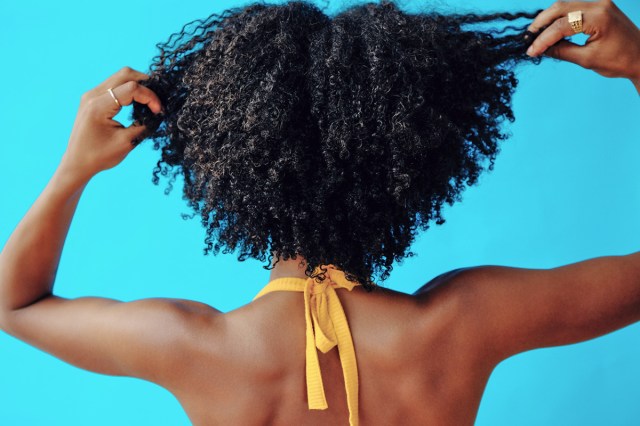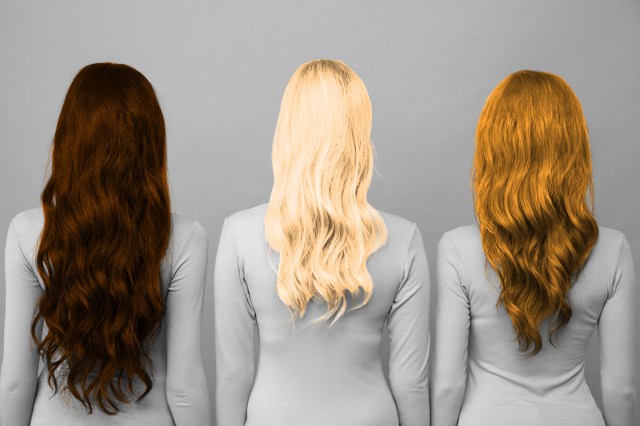
The Secret Is Melanin
While many plants and animals boast rainbows of color, natural human hair is confined to a select palette: black, brown, blonde, red, gray, and white. These colors are created by melanin, a pigment produced by specialized cells called melanocytes. Melanin gives color to keratin, the protein that forms hair and nails — without it, our hair would be colorless, just like our fingernails. This same phenomenon occurs in animal fur, which is why it generally features the same hues as human hair.
Two types of melanin contribute to hair color: eumelanin (a dark pigment responsible for brown or black hair) and pheomelanin (a light pigment responsible for red, orange, or yellow hair). The balance between those pigments determines hair color: Those with more eumelanin have brunette or black hair, while those with more pheomelanin have auburn hair. Blonde hair is a result of low levels of both melanin types. As we age, our bodies lose melanocytes and stop producing melanin for our hair, leading to inevitable graying and eventual hair whitening.

It’s in Your Genes
The amount of melanin your body produces depends on your genetics. One of the key players in hair color is the melanocortin 1 receptor (MC1R) gene, which influences the production of eumelanin.
When this gene is active in the melanocytes, it stimulates them to make eumelanin, resulting in a darker hair hue. When it’s inactive, pheomelanin takes the lead, resulting in redder hues. Whether or not this gene is active depends on your own DNA, and this is just one gene in a complex web of genetic factors that determine the color of your hair. It’s not a simple formula but rather a blend of inherited traits passed down from your parents and grandparents.

So Why Not Other Colors?
Human vision can differentiate between more than a million colors, so why do we have only a few possible hair colors? The color of anything is determined by how that thing absorbs and reflects light. For example, grass is green because it contains chlorophyll, a pigment that absorbs light (specifically red and blue wavelengths) but reflects green wavelengths. Those green wavelengths bounce back at us, and our eyes perceive them as green.
Melanin in hair works similarly, absorbing all the colors of light — such as blue, green, and violet — aside from the ones we see in hair. Variations in the chemical structure of melanin (for example, levels of eumelanin versus pheomelanin) determine which colors are absorbed or reflected. If melanin is absent, as in the case of albinism or aging, light passes through unfiltered, giving the hair a white or grayish appearance.
Interestingly, the color of our irises is also determined primarily by melanin, but the mechanics are different, resulting in blues and greens not seen in natural hair color. Everyone has layers of melanin in their eyes, and the amount of melanin determines iris color. Brown eyes result from an abundance of melanin in both layers of the iris (front and back). Those with hazel or green eyes have a thinner layer of melanin at the front of the iris than those with brown eyes. Blue eyes, meanwhile, have minimal amounts of melanin in the front layer.
More Interesting Reads

Will We Ever Evolve To Have Blue Hair (or Other Colors)?
It’s unlikely that humans will ever evolve to produce hair colors in more exotic hues. That would require radical changes to the structure of melanin itself on a molecular level. Since there are at least 11 genes that contribute to human hair color, a mutation capable of producing a new, natural color of melanin would require multiple highly specific — and extremely unlikely — gene mutations.
However, stranger things have happened. If, for some reason, blue or purple hair ever proved to be significantly advantageous for humans as a species (as protection from a threat, for instance), we may see a surprising genetic shift. For now, melanin and the colors it produces act as our body’s weapons against the sun.
Darker shades of hair, skin, and eyes provide better protection against UV damage, which is why people with paler skin are more easily sunburnt and why those with blue eyes are more light-sensitive. In the same way, blonde hair is more susceptible to damage from UV rays. So if humans ever do evolve to produce new types of melanin, we might expect it to be a darker hue that can still protect us from the sun’s rays.












